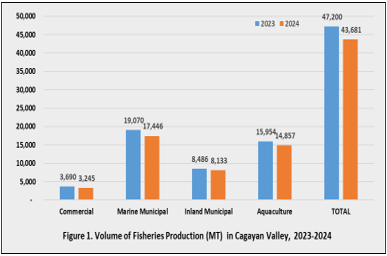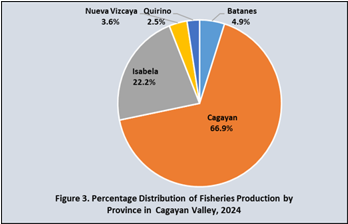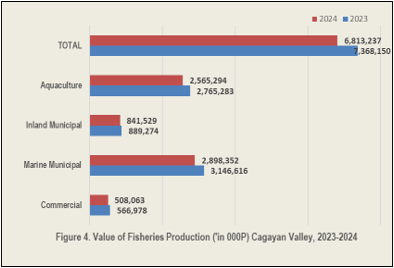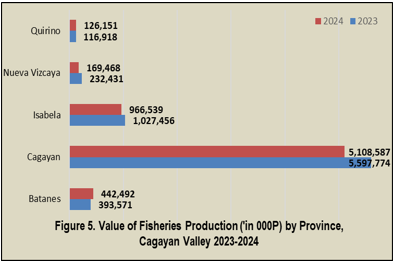This Special Release presents the fisheries production statistics of Cagayan Valley for the year 2024. It includes estimates on the volume and value of production, which serve as inputs for policy formulation, as well as for the planning and implementation of fisheries-related programs and projects. The data featured in this report are based on the latest available results from various fisheries surveys spearheaded by the Fisheries Statistics Division of the Economic Sector Statistics Service under the Sectoral Statistics Office of the Philippine Statistics Authority (PSA). These data were sourced from the PSA’s official statistics database at www.openstat.psa.gov.ph.
Total fishery production in 2024 was recorded at 43,681 metric tons, marking a 7.5 percent decline from the 47,200 metric tons produced in 2023. The decrease of 3,519 metric tons was driven mainly by lower output in the Marine Municipal sub- sector, while modest declines were also observed across all other sectors.

The Commercial Fishing sub-sector registered a total production of 3,245 metric tons in 2024, down from 3,690 metric tons in 2023. This translates to a 12.1 percent decrease, or a reduction of 445 metric tons. Meanwhile, Marine municipal fisheries, which consistently contribute the highest among the sub-sectors, posted a production of 17,446 metric tons in 2024.
This marks a decline of 1,624 metric tons or 8.5 percent from the 19,070 metric tons recorded in 2023. The drop can be attributed to various factors such as weather disturbances resulting to reduced fishing days.
Inland municipal fisheries sub-sector followed the same downward trend, with production declining from 8,486 metric tons in 2023 to 8,133 metric tons in 2024. This represents a decrease of 353 metric tons or 4.2 percent. While the reduction is relatively modest, it still signals possible impacts of environmental conditions and weather disturbances during the year.
Aquaculture production also saw a decrease, falling from 15,954 metric tons in 2023 to 14,857 metric tons in 2024. This is a decline of 1,097 metric tons or 6.9 percent. The slight drop was due to factors such as weather disturbances (dry spell in Sem 1 and series of typhoons in Sem 2) and operational limitations among aquafarm operators.

In 2024, Municipal Marine Fisheries had the largest share of the total fishery production in Region II at 39.9 percent. This shows that coastal fishing continued to be the main source of fish in the region.Aquaculture followed closely, contributing 34.0 percent to the total. It remained a vital and consistent source of fish, helping sustain the food supply despite minor fluctuations in production Inland Municipal Fisheries made up 18.6 percent of the total fish production in the region. Lastly, Commercial Fisheries had the smallest share at only 7.4 percent. This was due to a big drop in production compared to last year, because of fewer fishing trips and higher cost of inputs.
In 2024, Municipal Marine Fisheries had the largest share of the total fishery production in Region II at 39.9 percent. This shows that coastal fishing continued to be the main source of fish in the region.Aquaculture followed closely, contributing 34.0 percent to the total. It remained a vital and consistent source of fish, helping sustain the food supply despite minor fluctuations in production Inland Municipal Fisheries made up 18.6 percent of the total fish production in the region. Lastly, Commercial Fisheries had the smallest share at only 7.4 percent. This was due to a big drop in production compared to last year, because of fewer fishing trips and higher cost of inputs. In 2024, Municipal Marine Fisheries had the largest share of the total fishery production in Region II at 39.9 percent. This shows that coastal fishing continued to be the main source of fish in the region. Aquaculture followed closely, contributing 34.0 percent to the total. It remained a vital and consistent source of fish, helping sustain the food supply despite minor fluctuations in production Inland Municipal Fisheries made up 18.6 percent of the total fish production in the region. Lastly, Commercial Fisheries had the smallest share at only 7.4 percent. This was due to a big drop in production compared to last year, because of fewer fishing trips and higher cost of inputs.
During the year, Cagayan province contributed the largest share to Cagayan Valley’s total fishery production at 66.9 percent. This means that more than two-thirds of the region’s fish came from Cagayan, highlighting its strong coastal and aquaculture industries. Isabela ranked second with a 22.2 percent share, supported by its active inland and aquaculture production. Batanes, despite its small size, made a notable contribution of 4.9 percent. Fishing remains an important part of life in the island province, especially through marine municipal activities. Nueva Vizcaya and Quirino, both landlocked provinces, had smaller shares at 3.6 percent and 2.5 percent, respectively. Their fishery output mainly came from inland waters and aquaculture.
During the year, Cagayan province contributed the largest share to Cagayan Valley’s total fishery production at 66.9 percent. This means that more than two-thirds of the region’s fish came from Cagayan, highlighting its strong coastal and aquaculture industries.Isabela ranked second with a 22.2 percent share, supported by its active inland and aquaculture production. Batanes, despite its small size, made a notable contribution of 4.9 percent. Fishing remains an important part of life in the island province, especially through marine municipal activities. Nueva Vizcaya and Quirino, both landlocked provinces, had smaller shares at 3.6 percent and 2.5 percent, respectively. Their fishery output mainly came from inland waters and aquaculture.

Among the four major subsectors, marine municipal fisheries contributed the highest value both in 2023 and 2024. However, its production value dropped from PhP 3.15 billion in 2023 to PhP 2.90 billion in 2024, marking a 7.9 percent contraction. Similarly, the commercial fisheries subsector recorded a notable decline of 10.4 percent, from PhP 566.98 million in 2023 to PhP 508.06 million in 2024. The inland municipal fisheries sector also experienced a 5.4 percent dip in value, reaching PhP 841.53 million in 2024 from PhP 889.27 million the year before. Meanwhile, the aquaculture subsector, which typically contributes significantly to the region’s fisheries economy, registered a value of PhP 2.57 billion in 2024. This figure was 7.2 percent lower than the PhP 2.77 billion posted in 2023.

The overall downward trend in the value of production was attributed to various factors such as reduced catch volumes, unfavorable weather condition or rising input costs.
As to value of fisheries production across provinces ofthe region, Cagayan remained the top contributor, accounting for 74.9 percent of the region’s total fisheries production value. However, it saw a drop of 8.7 percent, from PhP 5.60 billion in 2023 to PhP 5.11 billion in 2024. Isabela, which contributed 14.2 percent of the regional total, also experienced a 5.9 percent decrease, with values declining from PhP 1.03 billion to PhP 966.54 million. Nueva Vizcaya contributed 2.5 percent to the regional total but recorded the sharpest drop at 27.1 percent, from PhP 232.43 million in 2023 to PhP 169.47 million in 2024.
On the other hand, Batanes showed a 12.4 percent increase, with its fisheries production value rising from PhP 393.57 million to PhP 442.49 million, representing 6.5 percent of the regional total. Quirino posted a 7.9 percent increase, contributing 1.9 percent to the region’s total, with values going up from PhP 116.92 million in 2023 to PhP 126.15 million in 2024.

During the year, the top ten species produced in Region II highlight the region’s strong dependence on both aquaculture and capture fisheries resources. Tilapia remained the most dominant species, with a production volume of 13,426 metric tons. This specie continues to be the primary output of the aquaculture sub-sector, serving as a major source of food and livelihood across the region.
Following tilapia, Whiteleg shrimp (Penaeus vannamei) ranked second with a production of 3,441 metric tons. This high-value aquaculture specie reflects the growing investment in shrimp farming in the region. Frigate tuna ranked third, with a total production of 2,513 metric tons. This specie is commonly caught in the coastal waters of Cagayan, Isabela, and Batanes provinces.
Anchovies placed fourth with 2,161 metric tons, while hairtail followed closely with 1,559 metric tons. These small pelagic species are commonly caught in municipal waters and contribute significantly to local fish consumption. Carp, another aquaculture species, ranked sixth with a production of 1,503 metric tons, indicating its continued relevance in fish farming activities.
Roundscad (1,175 metric tons) and big-eyed scad (957 metric tons), both widely caught in coastal waters, ranked seventh and eighth, respectively. These species are popular among small-scale fishers. Completing the list are flying fish (906 metric tons) and yellowfin tuna (867 metric tons), which are important marine resources—flying fish being primarily caught in the waters of Batanes and yellowfin tuna in the coastal areas of Cagayan.
ENGR. GIRME M. BAYUCAN
(Chief Statistical Specialist)
Officer-in-Charge, RSSO II
/emdp/jcb
